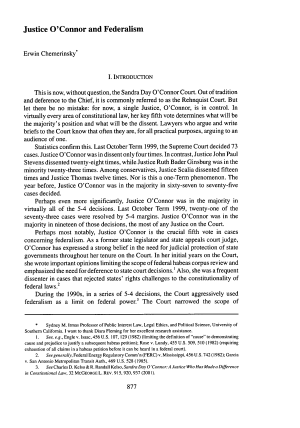Justice O'Connor and Federalism
January 1, 2001

DISCLAIMER: This text has been transcribed automatically and may contain substantial inaccuracies due to the limitations of automatic transcription technology. This transcript is intended only to make the content of this document more easily discoverable and searchable. If you would like to quote the exact text of this document in any piece of work or research, please view the original using the link above and gather your quote directly from the source. The Sandra Day O'Connor Institute does not warrant, represent, or guarantee in any way that the text below is accurate.
Article Text
(Excerpt, Automatically generated)
Justice O'Connor and Federalism
Erwin Chemerinsky•
I. INTRODUCTION
This is now, without question, the Sandra Day O'Connor Court. Out of tradition and deference to the Chief, it is commonly referred to as the Rehnquist Court. But let there be no mistake: for now, a single Justice, O'Connor, is in control. In virtually every area of constitutional law, her key fifth vote determines what will be the majority's position and what will be the dissent. Lawyers who argue and write briefs to the Court know that often they are, for all practical purposes, arguing to an audience of one.
Statistics confirm this. Last October Term 1999, the Supreme Court decided 73 cases. Justice O'Connor was in dissent only four times. In contrast, Justice John Paul Stevens dissented twenty-eight times, while Justice Ruth Bader Ginsburg was in the minority twenty-three times. Among conservatives, Justice Scalia dissented fifteen times and Justice Thomas twelve times. Nor is this a one-Term phenomenon. The year before, Justice O'Connor was in the majority in sixty-seven to seventy-five cases decided.
Perhaps even more significantly, Justice O'Connor was in the majority in virtually all of the 5-4 decisions. Last October Term 1999, twenty-one of the seventy-three cases were resolved by 5-4 margins. Justice O'Connor was in the majority in nineteen of those decisions, the most of any Justice on the Court.
Perhaps most notably, Justice O'Connor is the crucial fifth vote in cases concerning federalism. As
